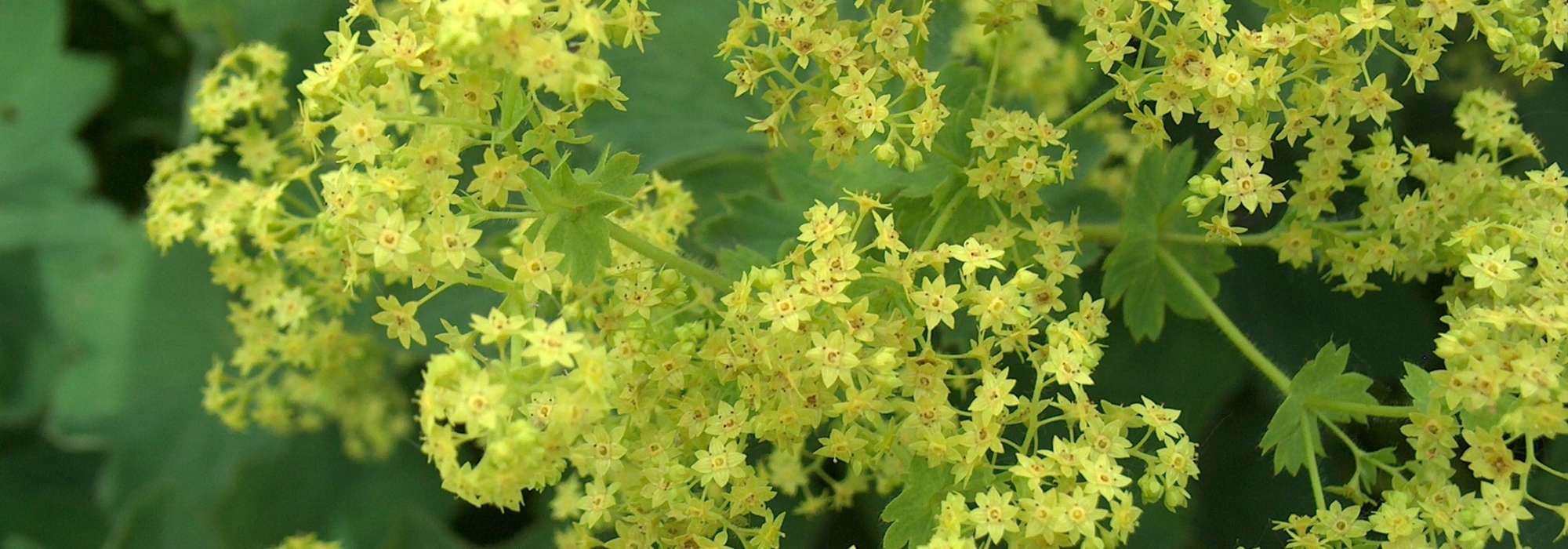
Alchemilla: planting, growing and care
Contents
Alchemilla in a nutshell
- Alchemilla is a charming perennial that produces clouds of chartreuse flowers in late spring
- Its remarkable foliage gracefully welcomes morning dew drops
- It is a hardy plant, low-maintenance, that does not require much care
- Its chic and trendy yellow-green flowering enlivens borders
- There are small varieties available, perfect for rockeries
A word from our expert
Lady’s mantle is one of the reliable perennials, essential for the garden. It is quite a versatile plant, perfect for dressing the base of roses, creating a pleasant ground cover, or edging a flower bed. In borders, it acts as the enhancer that magnifies and reinforces the beauty of its companions, which it highlights without overshadowing.
Its flowering consists of a multitude of small flowers, forming a chartreuse green froth above foliage of poetic beauty. How can one resist the charm of its rounded leaves that open like origami and gracefully collect the dew drops?

Lady’s mantle and dew drops
Lady’s mantle is a graceful perennial with a delicate appearance. However, it is also solid and hardy! Robust and easy to grow (even for beginner gardeners), it has the added advantage of growing quickly to form a large cushion.
Lady’s mantle is inseparable from English and classic gardens. Its exquisite beauty, modest and discreet, elegantly blends and harmonises with bushes, grasses, and other perennials. However, its graphic foliage and trendy acid yellow flowering do not look out of place in a modern or urban garden.
Botany
Botanical data
- Latin name Alchemilla
- Family Rosaceae
- Common name lady's mantle
- Flowering from May to October, depending on the varieties
- Height 0.15 to 0.45 m
- Exposure partial shade, non-burning sun
- Soil type cool but well-drained, adaptable to all soils
- Hardiness -15°C
Lady’s mantle is a genus of herbaceous perennial that belongs to the vast family of Rosaceae (like strawberries, wild rose, or rowan!). The Rosaceae are primarily found in temperate regions of the Northern Hemisphere. Among the most important genera, the genus Alchemilla comprises 250 species.
These are mainly ground-cover plants that form a spreading, rounded tuft with small, petal-less flowers that are yellow-green (known as chartreuse green).
The leaves of lady’s mantle are rounded and palmatilobate (lobed like a hand). They open like a fan and consist of 3 to 5 lobes with wavy and dentate edges, exhibiting a subtle and delicate beauty. They are most often covered with hairs that make the leaf water-repellent, forming charming beads of rainwater or dew. This mysterious feature intrigued alchemists who saw it as a magical water, ideal for creating the philosopher’s stone. They called it “celestial water”. This is, in fact, where its name comes from.
The flowers, a yellowish-green, are quite small and borne in corymbiform cymes on slender stems above the foliage, giving the plant a very decorative, airy appearance. They are interesting in bouquets of fresh or dried flowers and both the leaves and flowers are used in floral arrangements.

Alchemilla vulgaris – botanical illustration
Lady’s mantle also possesses medicinal properties that were widely used in the Middle Ages. It is renowned for its astringent, calming, and healing virtues. Often referred to as “women’s plant”, it treats gynaecological disorders. It can also be used to flavour dairy products, herbal teas, and tea, and livestock seems to appreciate it as well.
Alchemilla also intrigues botanists because it can multiply by apomixis, meaning it can produce seeds without fertilisation of the flower! The seeds thus yield plants identical to the mother plant. Ultimately, the result is the same as for propagation by cuttings. This is very useful for gardeners who wish to maintain identical plants.
In the garden, lady’s mantle is a plant suited to heavy, clayey soil that is conveniently adaptable to any soil. It is also very easy to maintain and spreads quickly, which is rewarding for the beginner or busy gardener.
Its uses are multiple: of medium to small size, it can fit in among other perennials, amidst spring bulbs, form ground covers, and highlight a path or even edge a border. The smaller varieties (such as Alchemilla alpina or Alchemilla epsisila) can also nicely adorn shady rockeries.
The discreet beauty of lady’s mantles makes them good basics for the garden. They integrate well into a natural garden when associated with foxgloves, lupins, and bellflowers or a classic garden with roses. When paired with dark foliage, lady’s mantles will shine in a contemporary garden.

From left to right: Alchemilla alpina / Alchemilla erythropoda / Alchemilla mollis
The main varieties of lady's mantle
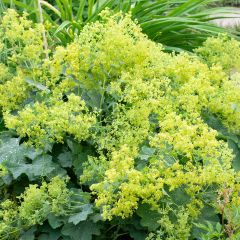
Alchemilla mollis
- Flowering time July to September
- Height at maturity 40 cm

Alchemilla erythropoda
- Flowering time July to October
- Height at maturity 30 cm

Alchemilla vulgaris
- Flowering time July to October
- Height at maturity 25 cm

Alchemilla alpina
- Flowering time July to October
- Height at maturity 15 cm
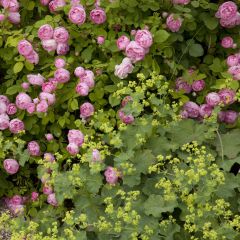
Charm Duo - Duo of Roses and Lady's Mantle
- Flowering time July to October
Discover other Alchemilla
View all →Available in 2 sizes
Available in 3 sizes
Available in 1 sizes
Available in 3 sizes
Available in 1 sizes
Available in 1 sizes
Available in 1 sizes
Available in 1 sizes
Planting lady's mantle
Where to plant?
Alchemillas are not demanding. They adapt to all soils, provided they are not too dry. They prefer light semi-shade; scorching sun is not suitable for them as it tends to scorch their leaves.
When to plant?
Alchemillas can be planted at any time of the year, except during frost periods, as they are offered in buckets. However, autumn (September-October) and spring (late March to May) are always preferable.
How to plant?
Alchemillas are planted like all perennials in buckets. Here are the steps to follow:
- Hydrate the root ball by immersing the bucket in a basin of water
- Prepare the ground by working it to a depth and width of 2 to 3 times the root ball
- If your soil is poor, amend it with fertiliser or well-matured compost and/or manure
- Dig and place the root ball so that the collar is level with the surface
- Firm the soil and create a watering basin around each root ball
- Water to settle
For humorous tips on how to approach planting, visit here!
Alchemillas can also be planted in pots or window boxes. As they can become quite large, choose the smaller varieties: A. epipsila or A. erythropoda, or even the spreading Alpine alchemillas. Due to the size of the perennials, window boxes are preferable. For a container 50 cm long, plan for 5 to 6 plants. Watering should be regular: the compost should remain moist and add liquid fertiliser every 15 days to the watering water.
Care
The only care that lady’s mantle requires is to cut back the plants after flowering. This helps to renew the foliage and encourages a resurgence in autumn. Additionally, it prevents them from self-seeding and becoming invasive.

At the end of flowering, cut back the entire plant to the ground to renew the dull foliage
Leave the foliage in autumn as it is semi-evergreen. It provides shelter for beneficial insects in winter and protects future leaves.
Lady’s mantle are robust plants that generally do not suffer from diseases or pests.
Multiplication
Lady’s mantle self-seeds. You can collect the seeds to sow them directly in place in autumn or in buckets.
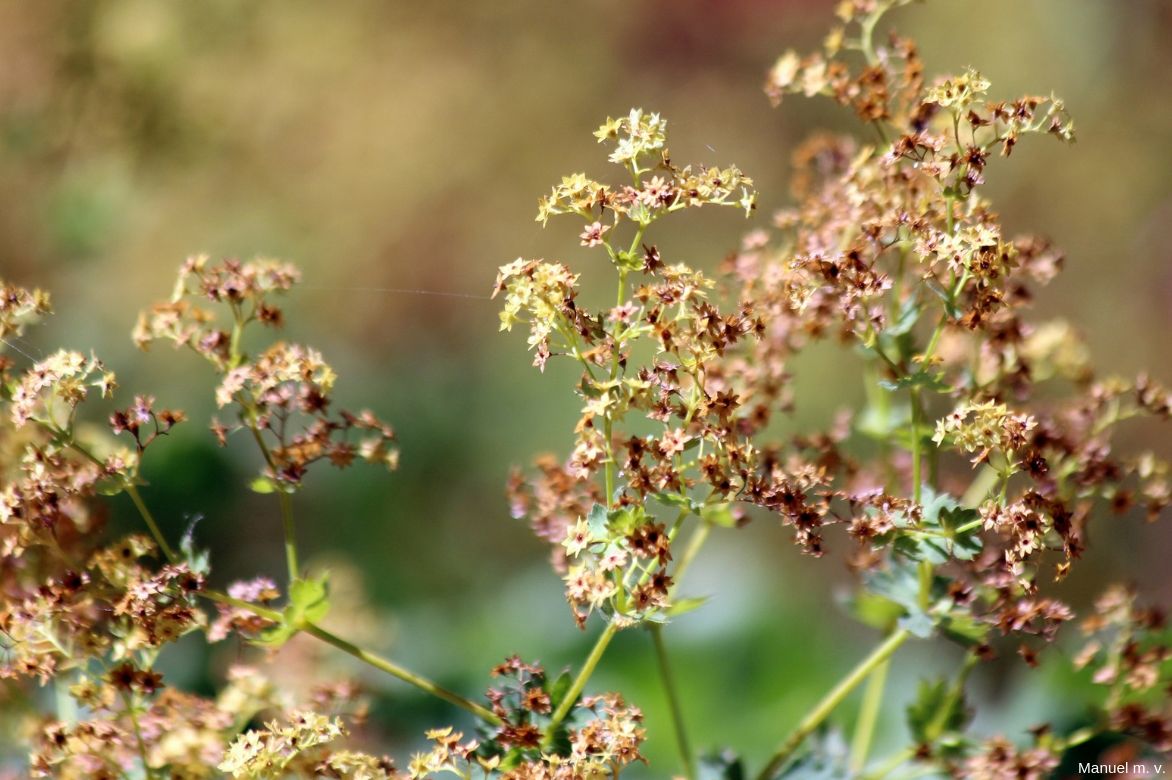
Faded flowers of lady’s mantle
The other method is to divide the large plants.
When and how to sow lady’s mantle?
The seeds need to undergo a cold period before germinating (vernalisation). If you sow in place, choose late summer so that winter induces germination. Otherwise, place the seeds in the refrigerator for a few weeks before sowing.
- In place, work the soil to a depth of 8 to 10 cm, incorporating potting soil or compost. In buckets, use special sowing compost.
- Sow and cover with a thin layer of potting soil
- Water gently to ensure the soil adheres to the seeds
For more detailed advice, check out this article on sowing.
When and how to divide lady’s mantle?
The ideal times are in March-April for spring and September-October for autumn.
Choose strong and healthy plants.
- Lift the clump with a fork
- Cut around the edge of the clump into sections of about 10 cm using a spade or knife
- Replant these offsets immediately, either in buckets or in place
- Water generously
Associating lady's mantle in the garden
Alchemilla plants are ideal for borders, and their beautiful foliage throughout the season can create a lovely ground cover beneath bushes. They soften the somewhat rigid or formal bases of hedges with their supple form. They are often used advantageously to balance the vibrant colours of spring bulbs and to hide fading flowers.
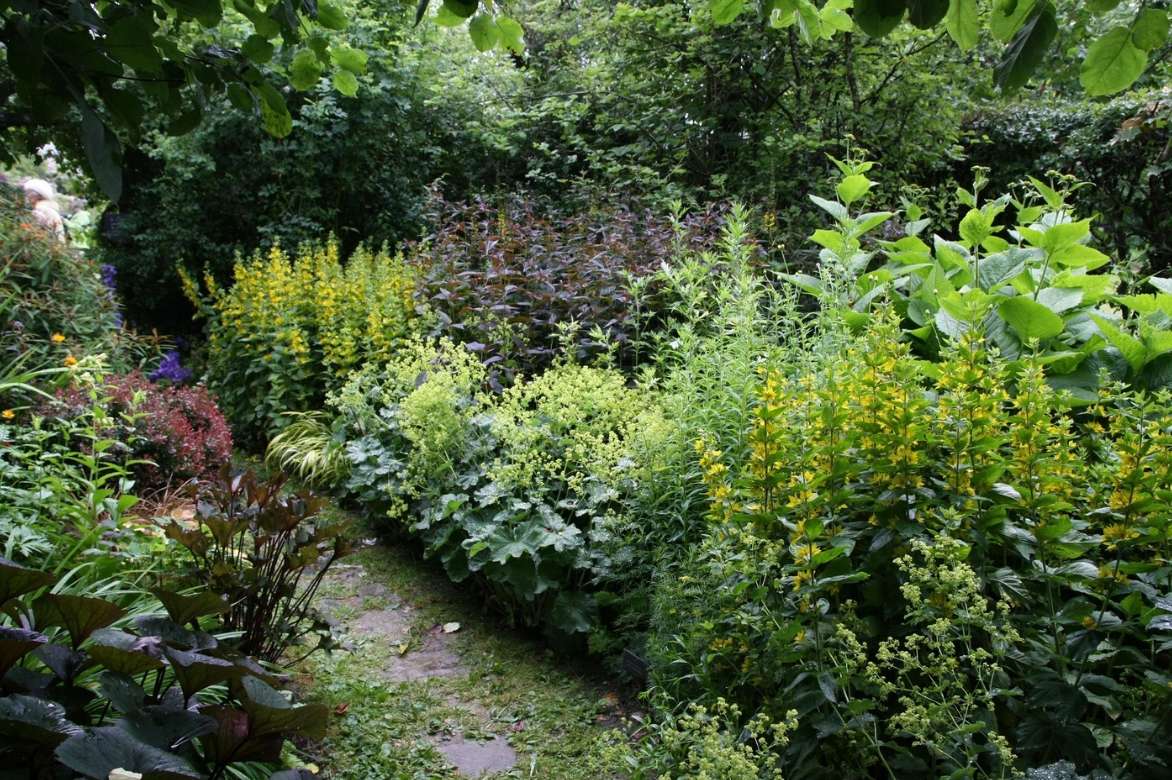
An example of association: Lysimachia punctata, Lysimachia ciliata ‘Fire Cracker’, Alchemilla mollis, Ligularia dentata ‘Britt Marie Crawford’, Berberis thunbergii ‘Atropurpurea Nana’, Hakonechloa macra ‘All Gold’ (Le jardin des Airelles, Francorchamps).
In an English-style border, they pair very well with roses, peonies, geums, alliums, campanulas, salvias… to visually link all these plants together and create a coherent and attractive ensemble.
Alchemilla plants will joyfully contribute to the mix of perennials, bulbs, and flowering bushes in romantic gardens.
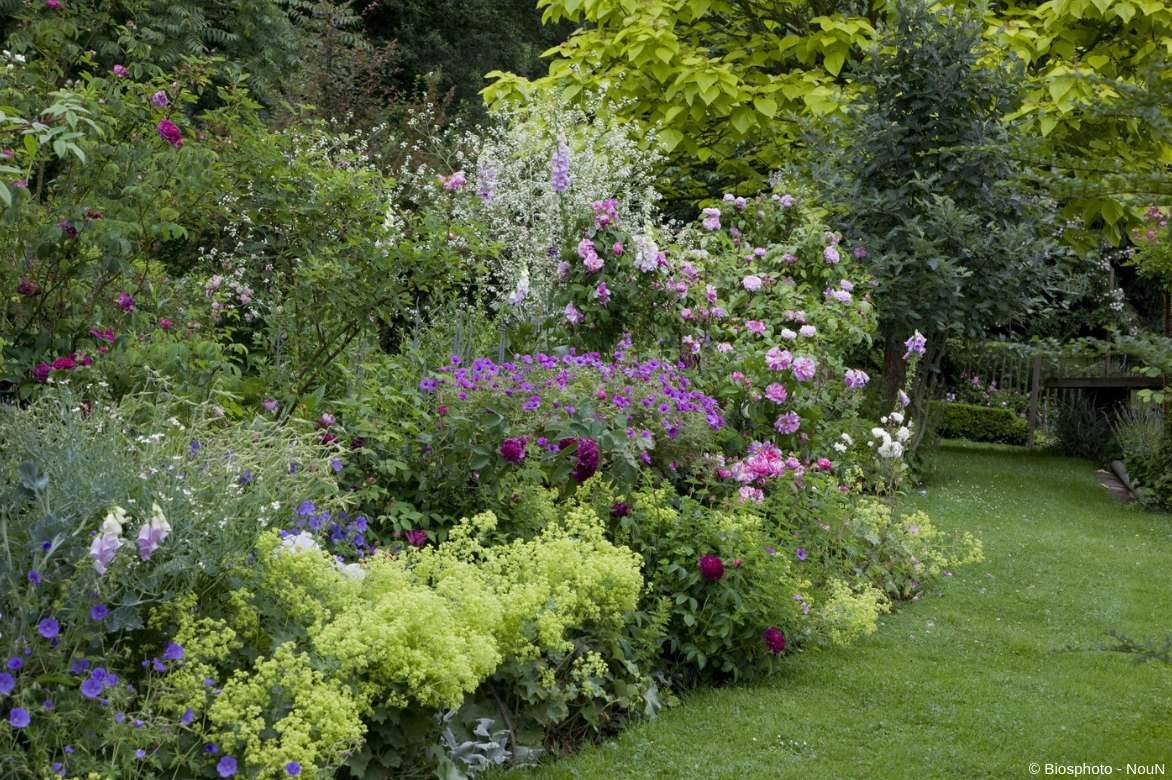
An example of association in a romantic setting: Alchemilla Mollis, Geranium ‘Patricia’, Digitalis purpurea, Crambe cordifolia, Rose ‘Versicolor’, Catalpa bignonioides ‘Aurea’. By pairing alchemilla with purple or burgundy foliage, you will create a strong focal point in a contemporary and sophisticated border.
A low border in shades of pink and green will consist of Alchemilla epipsila and a pink veronica from July to September. The ground orchid will add a refined touch in June-July. Autumn will be marked by the lovely waterlily colchicums and the heuchera “Pink Pearl” will enliven the whole throughout the year with its changing foliage.
→ Discover more association ideas with Alchemilla in our advice sheet.
Useful resources
- Discover our varieties of lady’s mantle.
- Article: Pairing lady’s mantle
- Article: Choosing a lady’s mantle
- Discover green-flowered perennials, gems of the plant world!
- Subscribe!
- Contents
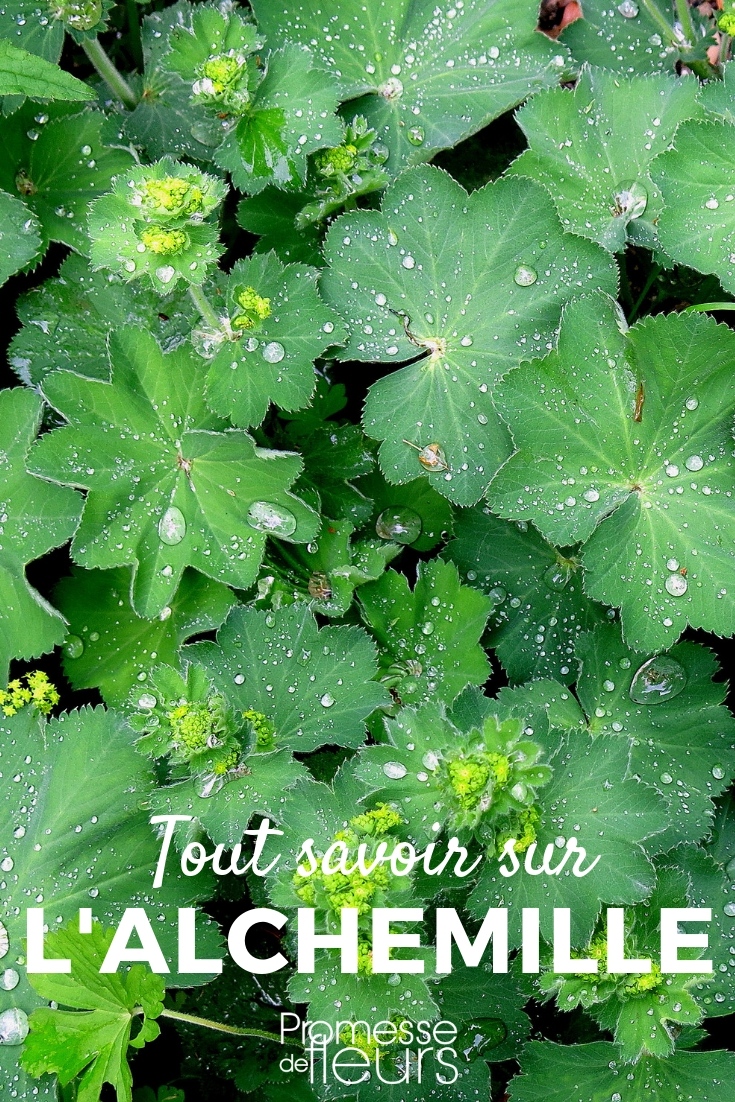































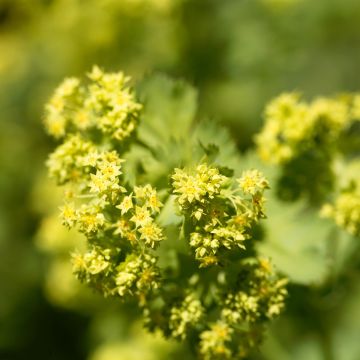



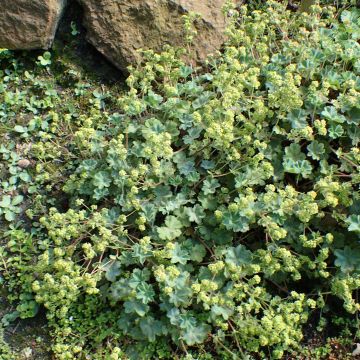
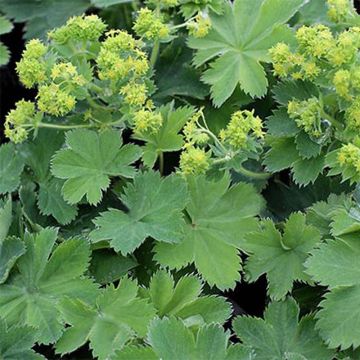
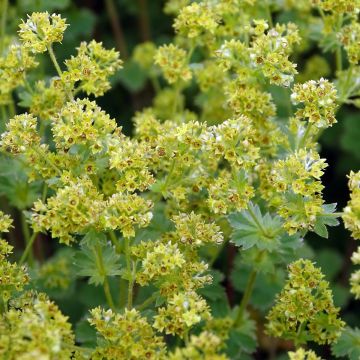

Comments